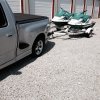Here’s what I have ran into. In my previous post I posted about a speedster SK I had bought. The SK has the twin 717/720 motors in it. Later in the thread I posted that my parents were going through some issues and were splitting up and I was given two 1997 SeaDoo SPX and a double trailer. I only wanted one of them originally but they gave me the whole package.
Looking into the boat I had to do some carb adjustment and I noticed that the 720 in the boat have a different manifold and only a single carb per motor. However I’ve worked on the spx for then before and both of those skis had the dual carb set ups. Just interested as to why they did that, and has anyone put the dual setups on the boats? Do they make more power with duals? Obviously I’m thinking single carbs in the boats are related to fuel efficiency.
Like I said. I’m just wondering, does this stuff switch over, and is there a benefit? Likely leave them as is, just curious.
Looking into the boat I had to do some carb adjustment and I noticed that the 720 in the boat have a different manifold and only a single carb per motor. However I’ve worked on the spx for then before and both of those skis had the dual carb set ups. Just interested as to why they did that, and has anyone put the dual setups on the boats? Do they make more power with duals? Obviously I’m thinking single carbs in the boats are related to fuel efficiency.
Like I said. I’m just wondering, does this stuff switch over, and is there a benefit? Likely leave them as is, just curious.




